Fireman First Class Grant Clark Cook, Jr.
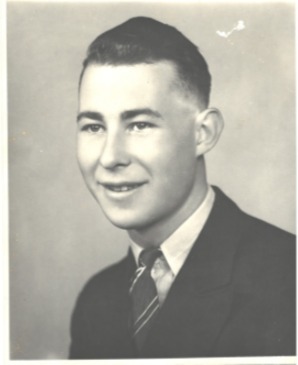
- Unit: USS Oklahoma
- Service Number: 003166631
- Date of Birth: July 27, 1921
- Entered the Military: July 17, 1940
- Date of Death: December 7, 1941
- Hometown: Cozad, Nebraska
- Place of Death: Pearl Harbor, Hawai'i
- Award(s): Purple Heart
- Cemetery: Courts of the Missing, Court 5, and Section P, Site 995. National Memorial Cemetery of the Pacific, Honolulu, Hawai'i
Mentored by Ms. Trysta Asche
Arcadia Public Schools
2020-2021
Early Life
Born on July 27, 1921, Grant Cook, Jr., was raised in Cozad, Nebraska, by his father, Grant Cook, Sr. and his aunt, Hazel Cook.
He had one sister named Jean Cook. His mother, Hazel Cook, died when he was four years old. She suffered from complications during pregnancy with Cook’s sister. Grant Cook, Jr., played football for the Cozad High School Haymakers and was known for his running pass. Given his speed, he also ran track in high school. Outside of school, he worked at the local service station.
Cook graduated from Cozad High School in 1939. He worked as a pinsetter at a bowling alley before he enlisted in the U.S. Navy in 1940. Both Grant Clark Cook, Jr., and his childhood best friend served and lost their lives in World War II.
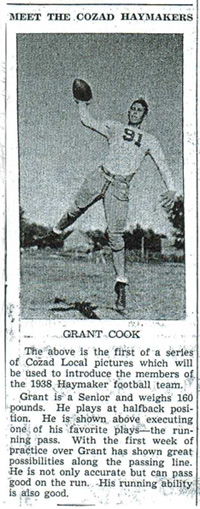
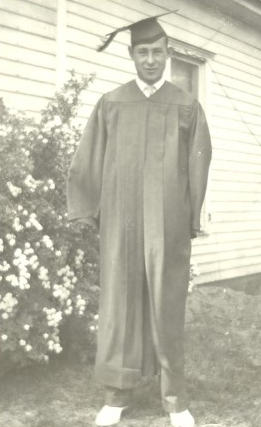
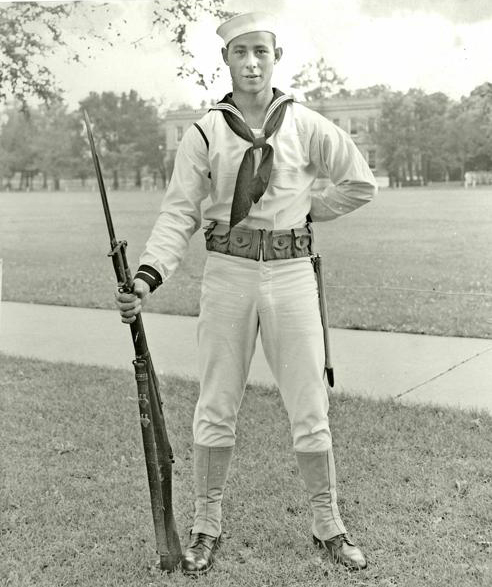
Homefront
The December 7, 1941 attack on Pearl Harbor changed the lives of all Nebraskans; in fact, 22 Nebraskans were killed on the U.S.S Arizona alone.
Nebraskans in 1941 came together with the common goal of achieving total victory. Most Nebraskans did not serve in the armed forces, but they did their part as civilians to help in the war effort. All Americans were required to ration, but rationing affected the rural areas, such as Nebraska. Towns like Cozad, North Platte, Gothenburg, Lexington, Arnold, Valentine, Thedford, O’Neill, Norfolk, Lincoln, and Omaha took part in a three-week scrap drive and produced over 67,000 tons of scrap metal.
Together, Nebraskans purchased nearly 240 million dollars worth of war bonds to help finance the effort. Men and women in the state took jobs that helped produce tanks, planes, and ammunition. Some people participated in scrap drives, literally picking up scraps to recycle for industry materials, and some even picked up gum wrappers and separated the tin foil from the paper. Their goal was to have a five-pound ball of foil and then start over.
Many people from Cozad made personal sacrifices. Some men chose to leave the family farm to work in factories; many women and children took care of the farm while the men were directly contributing to providing supplies for the effort. Like Cozad, schools closed their doors on specific days so that students could help with scrap drive. Children often went door to door in their neighborhoods collecting any scraps: any metal, engine grease, paper, or rubber. The sacrifices that Nebraskans made generated a strong sense of community and a patriotic feeling that everyone was helping in the war effort.
Military Experience
Enlistment and Training
Grant Clark Cook, Jr., enlisted in the U.S. Navy on July 17, 1940, in Omaha, Nebraska. For training, Cook traveled to the Great Lakes Naval Station, located near the southwestern shore of Lake Michigan in Chicago. He spent three weeks in the Fireman Apprenticeship Training program, a course on naval engineering fundamental skills in shipboard operations and evolutions. After successful completion of this training, Cook served on the USS Oklahoma in Pearl Harbor, Hawaiʻi.
USS Oklahoma
Built in 1916, the USS Oklahoma served as the largest and most advanced ship in the U.S. Navy. It needed 2,166 sailors and Marines to function correctly and could travel 20,000 miles without refueling. Commissioned during World War I, the Oklahoma escorted supply and troop ships across the Atlantic Ocean. The Oklahoma protected these ships from German U-boats as they sailed back and forth from Europe and America.
After World War I, Oklahoma traveled the world to provide help where necessary. When Long Beach, California, experienced a disastrous earthquake in 1933, the commander of the Oklahoma sent sailors ashore to help police and firefighters. They helped to keep the peace so that the firefighters could do their job. In 1936, Oklahoma traveled to Spain to help evacuate American and European refugees fleeing the Spanish Civil War.
Following these ventures, the USS Oklahoma was reassigned to the Pacific Fleet, and the Oklahoma arrived at Pearl Harbor, Hawaiʻi, in December 1940.
Cook’s occupation, or specialty, in the U.S. Navy was Fireman First Class. While on the USS Oklahoma, Cook’s job meant keeping the fires burning in the ship’s boilers. These boilers powered the large turbines and the ship’s electricity. Cook was stationed aboard the USS Oklahoma from October 9, 1940, to December 7, 1941.
Attack on Pearl Harbor
Stationed on Battleship Row on December 7, 1941, USS Oklahoma faced heavy fire when the Japanese empire attacked the United States by surprise. The Japanese used dive-bombers, fighter-bombers, and torpedo planes to sink nine ships, including five battleships, and severely damage 21 ships. There were 2,402 Americans killed in the attack. Of those deaths, 1,177 were from the USS Arizona, and 429 were from the USS Oklahoma.
The crew onboard the USS Oklahoma did everything they could to fight back during the attacks. In the first ten minutes of the battle, eight torpedoes hit the USS Oklahoma, and it began to sink. A ninth torpedo hit the battleship as it sank into the mud.
Working in the boiler room during the attack, Cook was believed to have been killed within minutes of the first torpedo. He was awarded the Purple Heart for his service by the U.S. Navy. Cook was laid to rest in an unidentified grave with the remains of other sailors. However, on August 27, 2018, the Defense POW/MIA Accounting Agency exhumed and properly identified Grant Cook’s remains. He was finally buried on May 9, 2019, in the National Memorial Cemetery of the Pacific in Honolulu.
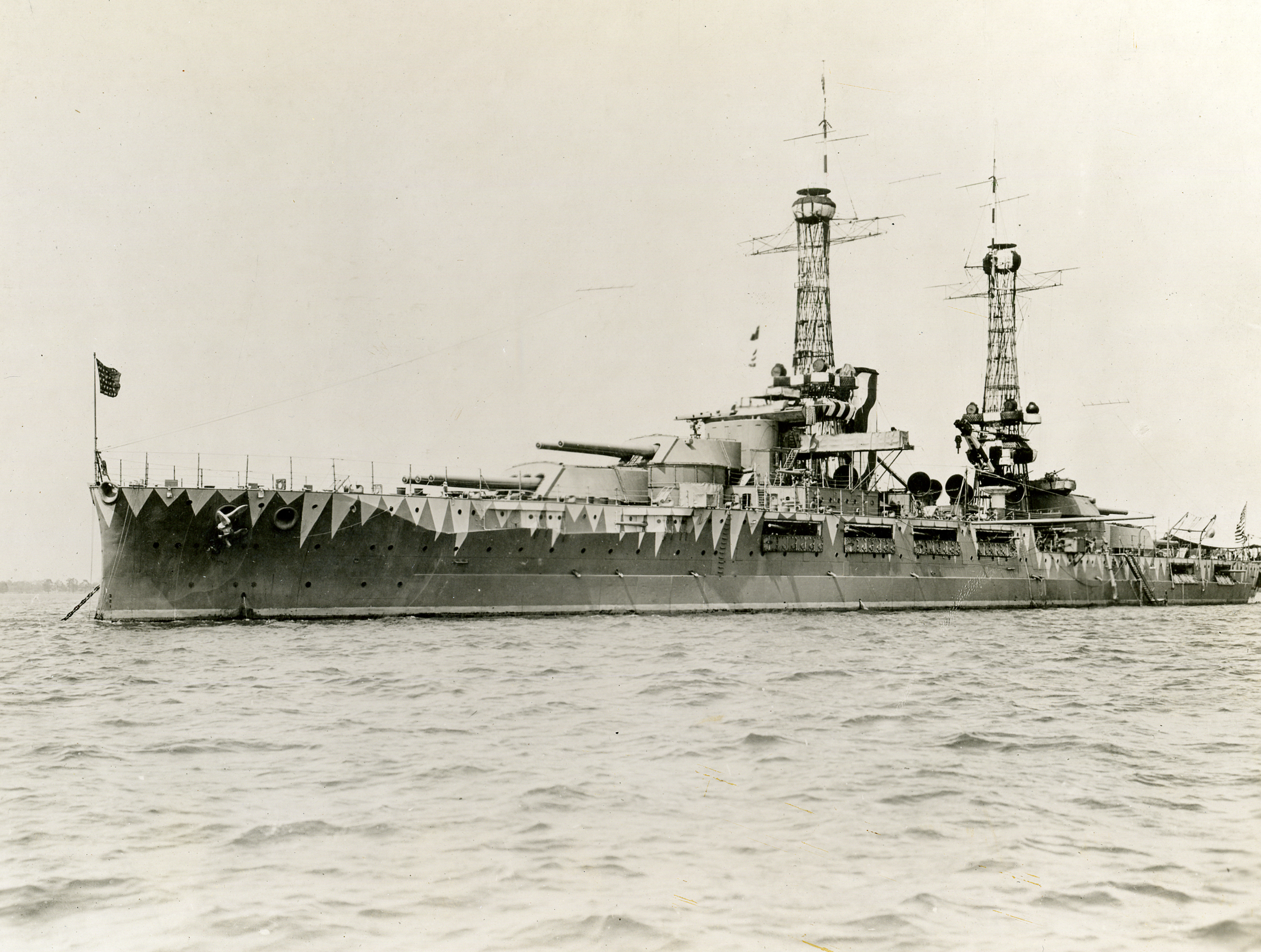
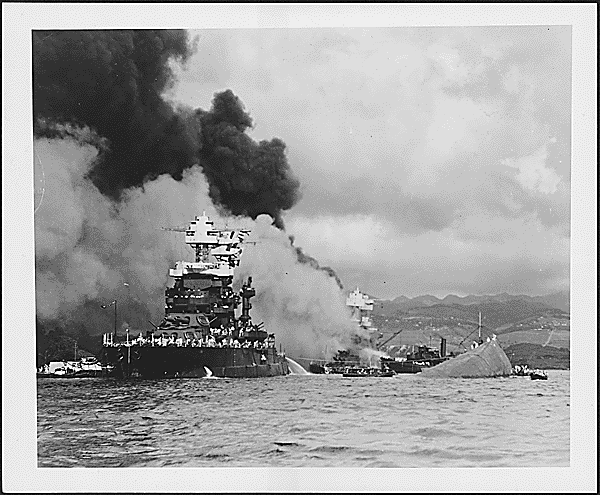
Eulogy
Born into a tight-knit family in Cozad, Nebraska, Grant Clark Cook, Jr., was like many other rural Nebraska kids. He valued family ties and acknowledged that hard work equaled success. At a very young age, Cook and his only sibling, Jean, lost their mother, who was only 24 years old. They were raised by their father, aunt, and grandfather. According to his sister, Jean Sheehand, Grant was “a good all-around guy, though perhaps a little bit mischievous.”
On July 17, 1940, in Omaha, Nebraska, Cook enlisted in the U.S. Navy to join the ranks of Firemen. Upon successful completion of this training, firemen served wherever the U.S. Navy needed them the most. In Cook’s case, this meant serving as a Fireman First Class on the USS Oklahoma in Pearl Harbor, Hawaiʻi. Cook was on the USS Oklahoma from October 9, 1940, to December 7, 1941.
During the first minutes of the attack, Cook died as he was working in the ship’s boiler room. At the time of his death, his remains were unidentified and buried with those of several other unidentified servicemen. Cook was one of 429 servicemen who died on the USS Oklahoma that day. In an interview with Cook’s sister, Jean Sheehan, Steve Liewer of the Omaha World-Herald discovered that “Cook died during the first minutes of the attack. Most of the servicemen who died were trapped below decks when the ship rolled over and sank to the bottom of the bay, and only 35 could be identified at the time.”
Liewer also stated that Cook’s remains were unidentified with those of other servicemember’s remains until 2018, when they were disinterred in order to attempt to identify them using modern DNA technology. These remains were shipped to a lab at Offutt Air Force Base in Nebraska to undergo the process of identification.
Although Sheehan had given a DNA sample to help in this process, it took another four years before receiving word that her brother had been identified. Cook was officially identified on August 27, 2018. She stated in the interview with Liewer, “He was very much loved,..It was wonderful to have a brother. And it was very hard to lose him.”
It was the sacrifices the men and women like Grant Cook, Jr. made that allow me to stand here today and honor him. During my time reflecting on his story, I have learned to appreciate the sacrifices that those not much older than myself have made for our country. I am honored to share his story and am thankful for all that I have learned from this experience.
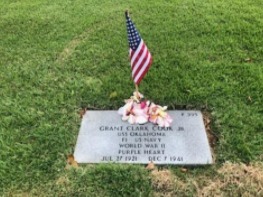
Reflection
When I first heard that my teacher and I had been chosen for this program, I was overjoyed. We could never have imagined how impactful and memorable this trip would be. I have learned so much over the last two years, from the first reading about the 100th Battalion and the 442nd Regimental Combat Team to reading our eulogies on the last day in Hawaiʻi. Not only have I learned about the history of Pearl Harbor and the heroes involved, but the power of people that chose to honor those lost and tell their stories. What an amazing program this is! Every aspect of this Sacrifice For Freedom®: World War II in the Pacific trip was perfect. I cannot imagine how dedicated the people involved in this program were and still are. I am so thankful for the people who made this trip possible. They are truly amazing.
Looking back on this trip and even as the days in Hawaiʻi came to an end I started to understand what made this trip such an amazing experience. It was the people. Not the places we went, but the ones who told the stories and the students and teachers. I have made lifelong friends. Before the trip was over we were already starting to plan a reunion. So many great personalities! They were the kind of people you never get tired of. As I move forward in life I will remember these people and the moments I shared with them.
Bibliography
Primary Sources
Andres, Judy. In-person interview by author. March 1, 2020.
Cook Family Photographs. Courtesy of Connie Ourada.
Grant Cook, Individual Deceased Personnel File, Department of the Army.
Grant Cook, Official Military Personnel File, Department of the Navy, Records of the Bureau of Naval Personnel, RG 24, National Archives and Records Administration – St. Louis.
Grant Clark Cook’s gravestone. Photograph. May 2019. Courtesy of Scott Schmidt
Grant Clark Cook. Headstone and Interment Records for U.S. Military Cemeteries on Foreign Soil, 1942-1949. ancestry.com.
Grant Clark Cook, Jr., Graduation Day Photo [Personal photograph taken in Cozad, Nebraska], May 1939.
Grant Clark Cook, Jr., Navy Uniform Photo [Personal photograph taken in Cozad, Nebraska], 1940.
Grant Clark Cook. National Memorial Cemetery of the Pacific (Punchbowl), 1941-2011. Photograph. ancestry.com.
Grant Clark Cook Jr. World War II and Korean Conflict Veterans Interred Overseas. ancestry.com.
Grant Clark Cook Junior. World War II Navy, Marine Corps, and Coast Guard Casualties, 1941-1945. ancestry.com.
Grant Clark Cook Junior. World War II Navy Muster Rolls, 1941 Digital Images. ancestry.com.
Grant Clark Cook Jr. U.S. Navy Casualties Books, 1776-1941. ancestry.com.
Nebraska. Dawson County. 1930 U.S. Federal Census. Digital Images. ancestry.com.
Nebraska. Dawson County. 1940 U.S. Federal Census. Digital Images. ancestry.com.
Schmidt, Lieutenant Colonel Scott. In-person interview by author. March 1, 2020.
USS Oklahoma (BB-37). Photograph. c.1917. Naval History and Heritage Command (NH 44401). www.history.navy.mil/content/history/nhhc/our-collections/photography/us-navy-ships/battleships/oklahoma-bb-37/NH-44401.html.
Secondary Sources
“Battleship Row.” National Park Service. Updated July 2, 2019. Accessed December 4, 2020. www.nps.gov/valr/learn/historyculture/battleship-row.htm.
Duggan, Joe. “Remembering the 1942 Nebraska Scrap Metal Drive.” Lincoln Journal Star, March 19, 2007. journalstar.com/news/local/remembering-the-1942-nebraska-scrap-metal-drive/article_44b311bb-ca27-556b-b4d4-716a0fd9b801.html.
“Grant Clark Cook Jr.” Find a Grave. Accessed August 31, 2020. www.findagrave.com/memorial/196347967/grant-clark-cook.
“Grant Clark Cook Jr.” Honor States. Accessed September 3, 2020. www.honorstates.org/index.php?id=83441.
“Sailor Who Died during Pearl Harbor Laid to Rest at the National Cemetery of the Pacific.” KITV Channel 4, May 9, 2019. www.kitv.com/story/40447119/sailor-who-died-during-pearl-harbor-laid-to-rest-at-national-cemetery-of-the-pacific.
Liewer, Steve. “No Longer ‘Unknown,’ Nebraska Sailor Who Died at Pearl Harbor Is ID’d at Offutt, Buried in Hawaii.” Omaha World-Herald, May 13, 2019. omaha.com/local/no-longer-unknown-nebraska-sailor-who-died-at-pearl-harbor-is-idd-at-offutt-buried/article_0feddb67-5057-5f47-9e2b-c6967fda5e7b.html.
Matthews, Lopez, Zachard Dabbs, and Eliza Mbughuni. “Remembering Pearl Harbor.” Prologue, Winter 2011 43(4). www.archives.gov/publications/prologue/2001/winter/ph-decklogs.html.
“Service Member: F1C Grant Clark Cook Jr.” Defense POW/MIA Accounting Agency. Updated October 17, 2018. Accessed October 1, 2020. dpaa.secure.force.com/dpaaProfile?id=a0Jt0000000XeKrEAK.
“USS Oklahoma.” The Encyclopedia of Oklahoma History and Culture, Oklahoma Historical Society. Accessed October 3, 2020. www.okhistory.org/publications/enc/entry.php?entry=US003.
“USS Oklahoma.” Oklahoma Historical Association. Accessed September 30, 2020. www.okhistory.org/learn/ussok.
“USS Oklahoma Sailor Accounted For From World War II (Cook, G.).” Defense POW/MIA Accounting Agency. Updated January 11, 2019. Accessed October 1, 2020. www.dpaa.mil/News-Stories/News-Releases/Article/1729565/uss-oklahoma-sailor-accounted-for-from-world-war-ii-cook-g/.

